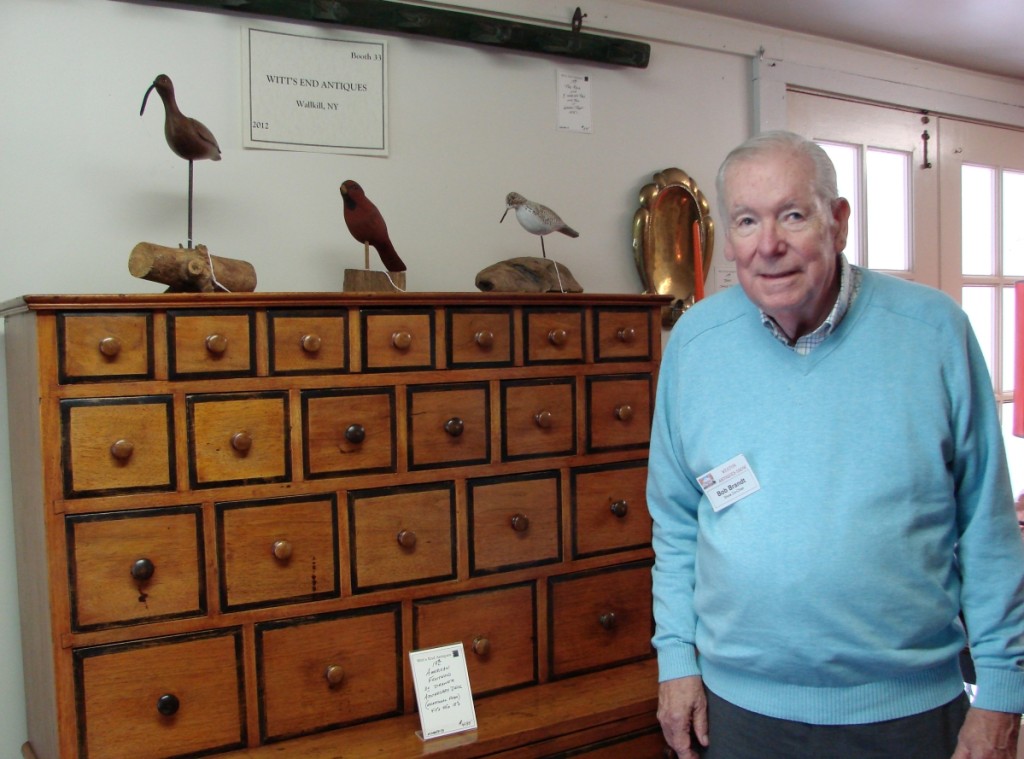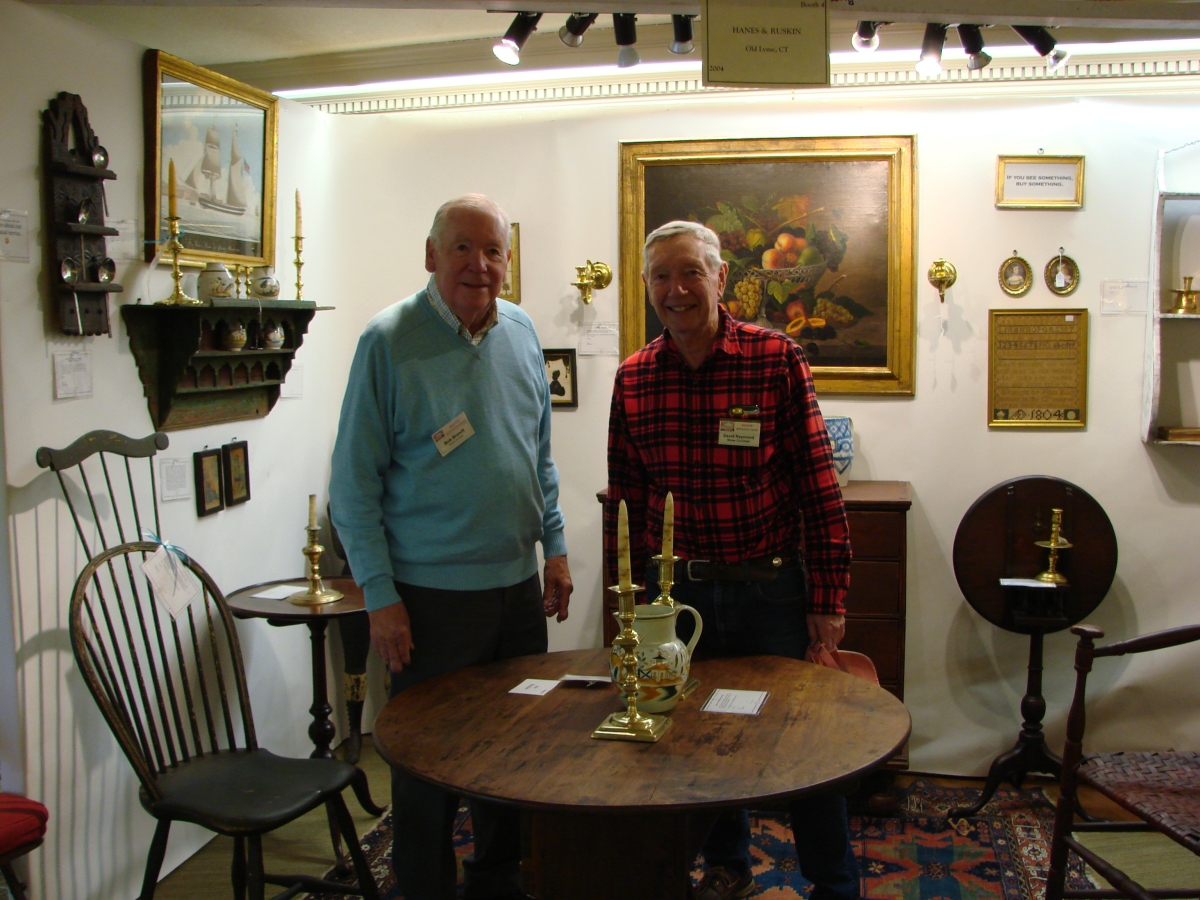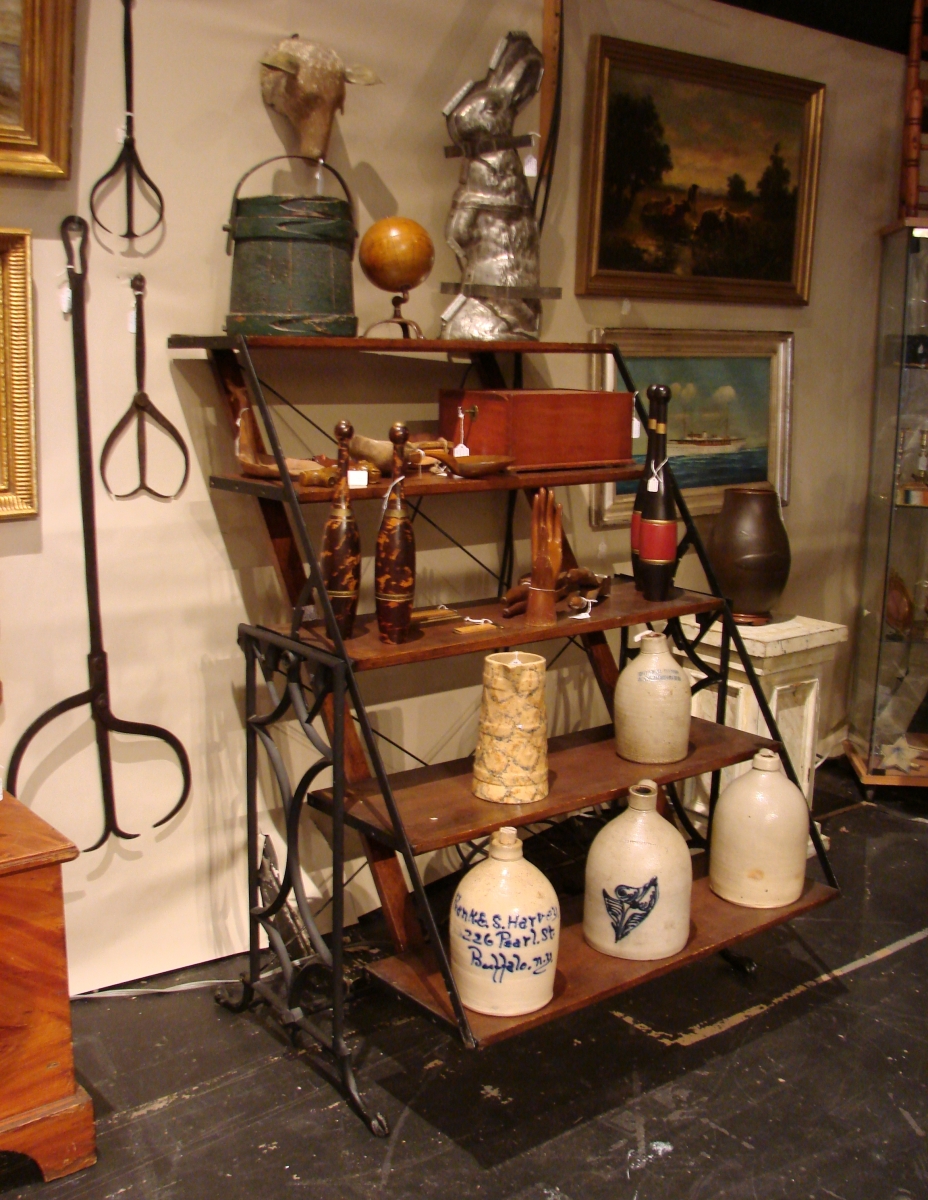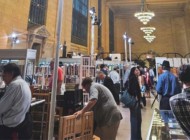
The heavily carved circa 1780 tall case clock in the corner of the booth of Harrison, Maine, dealer Harry Hepburn III was made by Joseph Atkinson in Ireland. The well-carved whale plaque by “Wick” Ahrens was priced at $8,775.
Review and Photos by Rick Russack
WESTON, VT. – Fortunately, some things don’t change all that much over time. The antiques show in Weston, which is the start of Antiques Week in Vermont, is one of those things. It’s not a large show, 30 dealers, but they are outstanding dealers and they save stuff all year long for the show. The turnover is low; there were just three new dealers this year: Mark and Marjorie Allen, the Rathbun Gallery and Randi Ona sharing a booth with Hollis Brodrick. One dealer, Esther Gilbert, has done each show since 1975, and Charlie and Barbara Adams have done it since 1978. The setting is the Weston Playhouse in the picturesque, small town of Weston, complete with a waterfall, Eighteenth Century homes and museums. If you’ve never been to this show, and you like American antiques, plan on visiting it next year.
Not many shows can make this claim, but this year’s show marks its 60th anniversary. It has been managed for the last several years by Bob Brandt and Dave Raymond. The building, originally a church built in 1830, went through several changes, and eventually became a theater. It burned in 1962 but was rebuilt the following year. It stands on the banks of the West River, and was flooded by Hurricane Irene in 2011, just a couple of weeks before the show was to open. Both the building and the show survived. The 30 dealers fill all the available space in the building: three floors, the stage and the auditorium. Interestingly, the signs for each booth identifying the dealers, include the date that they started doing the show.
Attendees come to buy, and they can choose from a wide variety of Eighteenth and Nineteenth Century antiques, with an emphasis on American-made objects and items that would have been used in American homes of those years. Most of the dealers are well-experienced show dealers, and the booths reflect that. Laconia, N.H., dealers Mark and Marjorie Allen’s booth, for example, as you might expect, included several pieces of early American furniture, Westerwald jugs, early iron food choppers, andirons, etc. But it was the presentation that was noteworthy. A circa 1730 gateleg table was set for dinner for four with circa 1750 English delft plates, a set of four circa 1805 bowback Windsor chairs in original paint, four Eighteenth Century twisted stem wine glasses, and each place setting included pieces of Nineteenth Century cutlery, all finished off with a large delft bowl and a pair of early brass candlesticks. Each was priced separately, but it would have made quite a setting in any early home. The table was priced at $2,950, the delft plates were priced at $1,500, and the wine glasses were individually priced.
Another noteworthy display was that of Oriental rug dealer Lori Frandino, Walpole, N.H. Those of us who are regular show attendees are accustomed to rug dealers neatly covering the walls of their booths with colorful rugs. However, we are not accustomed to seeing three walls of a large auditorium hung with rugs, and rugs opened and draped over the seating in the auditorium. Frandino’s booth included 123 rugs, all of which could be seen. Frandino has been doing the show for the last few years and at the last show sold 30 rugs, about the same the year before and more than 20 the year before that. Her most expensive rug this year, showing some wear, was a 10-by-13-foot serapi from the third quarter of the Nineteenth Century, and it was priced at $4,700. Most of her rugs were priced between $2,000 and $3,000.

When Bob Brandt, one the show managers, was asked to identify his favorite item in the show, he immediately mentioned the 39-drawer apothecary desk in the booth of Witt’s End Antiques, Wallkill, N.Y. It was priced at $4,195 and sold shortly after the show opened — but not to Brandt.
Although most of the material being offered dated to the Eighteenth and Nineteenth Centuries, there were some items clearly made in the mid-Twentieth Century. Ed Miller, Pioneer Folk Antiques, Ellsworth, Maine, had several interesting pieces of Twentieth Century folk art, including a figure of a goat (or a deer?) made of several pieces of sheet metal. It had a wonderful surface, lightly rusted and pitted. Priced at $695, it was attributed to self-taught artist Robert “Dan” Daniels from St George, Maine. Daniels’ works occasionally turn up at Maine auctions. The dealer had a metal sculpture depicting large birds in flight that was priced at $725 and a wonderful carved blue heron. Harry Hepburn III, a Harrison, Maine, dealer, had a group of superb whale carvings by “Wick” Ahrens, a noted Vermont carver. Ahrens, who studied under Carl Voorhees, died in 2016, in an assisted living facility funded by the state of Vermont. According to Hepburn, when the state agreed to fund his care, they required that his assets, including the carvings, be surrendered. They were eventually sold at auction and Hepburn bought more than 20 whale carvings at the sale. He had one, about 4 feet long, hanging on the back wall of his booth, priced at $8,775.
There was a large selection of early furniture. Hanes and Ruskin, Old Lyme, Conn., had a William and Mary four-drawer chest on ball feet, circa 1700-30, priced at $3,650. It sold on the first day of the show. Richard Schneider, Rathbun Gallery, Wakefield, R.I., who was doing the show for the first time, brought a country Chippendale one-drawer blanket chest with rosehead nails, priced at $2,100. Red Horse Antiques, Bridgewater, Vt., had an unusually small, early corner cupboard priced at $2,250, while Ponzi’s Antiques, Trumansburg, N.Y., had an exceptional Connecticut carved cherrywood secretary desk priced at $9,500. It was attributed to the school of Eliphalet Chapin of East Windsor, Conn., and was noted as having a restored base. Mark and Marjorie Allen, in addition to the early gateleg table described above, also had a circa 1760 Massachusetts tavern table. It was thought to be from the Hadley, Mass., area, and its detailed tag stated that it was “in better condition than the one in the front room of the Ashley house in Historic Deerfield.”
After the show, Bob Brandt said that the show went well. “Our attendance was off a bit, but several of our dealers told me that they had sold well. That’s important to us because we’ve learned that people who have bought at the show will be back next year, and they may bring some friends. So, during the show, I’m paying more attention to how many people are carrying things out than I am to how many people are coming through the door. The decline in attendance may have been due to the fact that we had to move the show up a week. There weren’t as many “leaf peepers” around this weekend since we weren’t at peak foliage, and if we can, next year we’ll go back to our previous scheduling. All in all, I think everyone was satisfied.”
For additional information, www.westonantiquesshow.org.





















